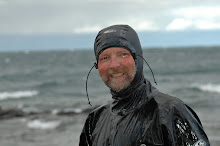
With both sons in town from opposite coasts, the VOR in Grand Marais for a family campout, and the weather absolutely perfect, I probably should have spent most of my time playing outside. For some inexplicable reason I found myself in the garage, tinkering with the kayaks instead of paddling in them. I did manage to get out for a lovely paddle on Lake Owasso, a lake I've never been on before, but most of the morning was spent working on the fleet.
Almost everyone adds a bit of foam or outfits their boat in some fashion. As the owner of a couple Valley boats, the quest for comfort is a bit more radical.
 Out of the three Valley boats in the fleet, we've managed to break the seats on two of them and it was only a matter of time before the third one went. The boats handle great, paddle wonderfully, and are as strong and tough as they come. The seats however, are miserable. Unlike the old Valley molded seats, these are ABS and bolted to the deck. The back band is guaranteed to fold down underneath the paddler after awhile and the relatively brittle ABS will break, especially when you're learning some of the more interesting forward finishing rolls. These rolls are unusually hard on seats as well as Greenland sticks while in the learning phase. Yesterdays exercise involved ripping the seat and footpegs out of the Q boat and repairing the seat and dumping the backband on the Aquanaut HV.
Out of the three Valley boats in the fleet, we've managed to break the seats on two of them and it was only a matter of time before the third one went. The boats handle great, paddle wonderfully, and are as strong and tough as they come. The seats however, are miserable. Unlike the old Valley molded seats, these are ABS and bolted to the deck. The back band is guaranteed to fold down underneath the paddler after awhile and the relatively brittle ABS will break, especially when you're learning some of the more interesting forward finishing rolls. These rolls are unusually hard on seats as well as Greenland sticks while in the learning phase. Yesterdays exercise involved ripping the seat and footpegs out of the Q boat and repairing the seat and dumping the backband on the Aquanaut HV. I'd managed to get my hands on a 3' x 3' square piece of ABS after thieves tried to break into my Thule ski box by smashing the hell out of it last winter. A coping saw, torch, and some highly noxious ABS cement will have the cracked and broken ABS part as good as new in no time. Plus by double reinforcing the stress area it may prevent a repeat failure. Cement the crack, heat up the patch with the torch to conform it to the part being repaired, slap the cement on both sides, and press on the patch and wait for it to dry. It looks ugly but it does the trick.
I'd managed to get my hands on a 3' x 3' square piece of ABS after thieves tried to break into my Thule ski box by smashing the hell out of it last winter. A coping saw, torch, and some highly noxious ABS cement will have the cracked and broken ABS part as good as new in no time. Plus by double reinforcing the stress area it may prevent a repeat failure. Cement the crack, heat up the patch with the torch to conform it to the part being repaired, slap the cement on both sides, and press on the patch and wait for it to dry. It looks ugly but it does the trick.That same coping saw can be used to shape the foam when seat and footpegs finally cause enough aggravation to be removed completely. Slicing off a bit at a time will allow the foam to be shaped perfectly for optimal comfort. I did purchase a foam seat from Chesapeake Light Craft, a seat that was in the Valley Skerry that GalwayGuy and I owned, a seat named, appropriately enough, the Happy Bottom pad. For a back rest I alternate between a shaped foam pad and an inflatable thigh support that seems to provide great support and flexibility for rolling.
Its tough to start cutting and wrenching on a pricey new boat but, as many others have also written, its well worth it in the end. Everyone has a different shape and modifying the boat to fit that shape exactly makes paddling more efficient, comfortable, and thus more fun.


1 comment:
Thanks, from the bottom of my bottom.
Post a Comment